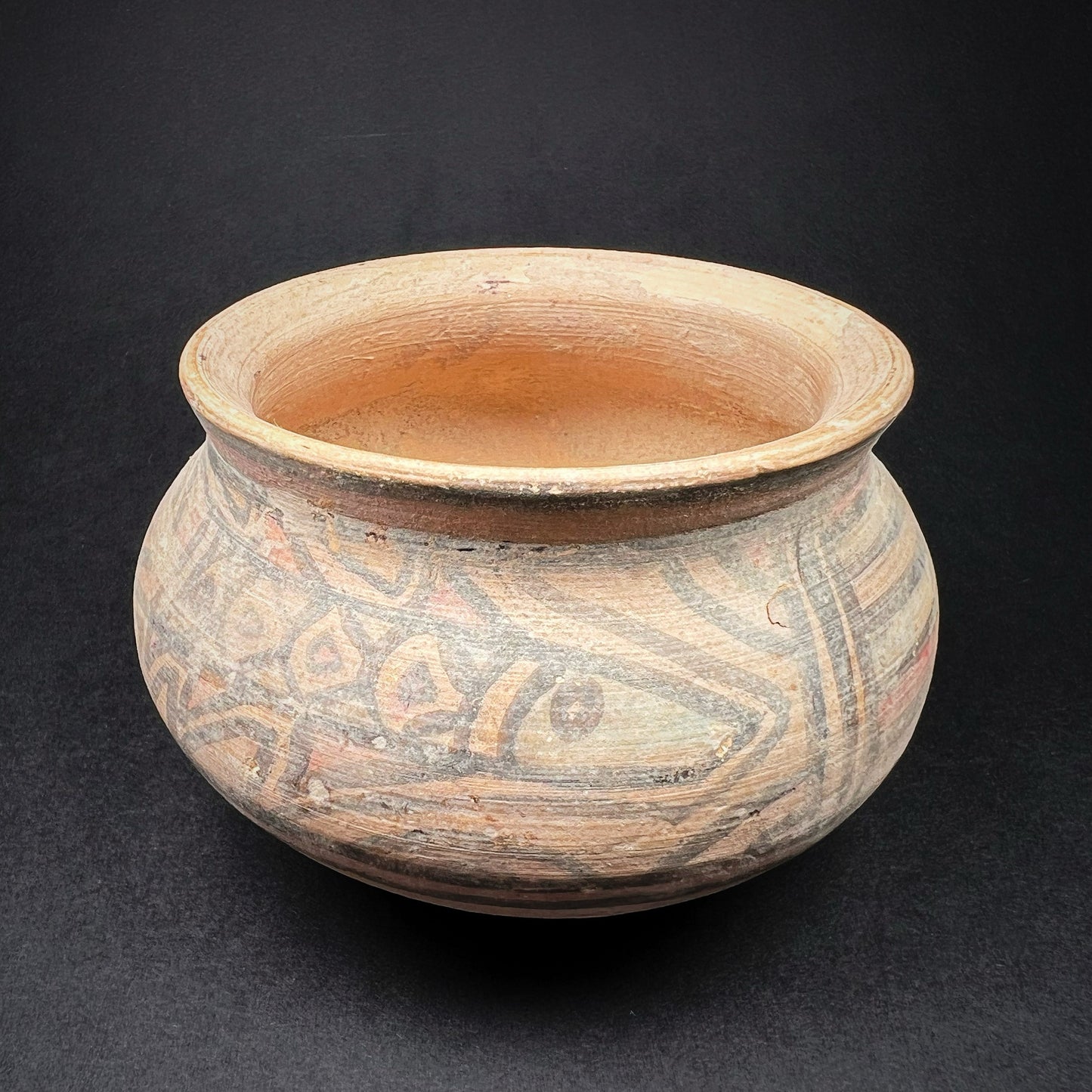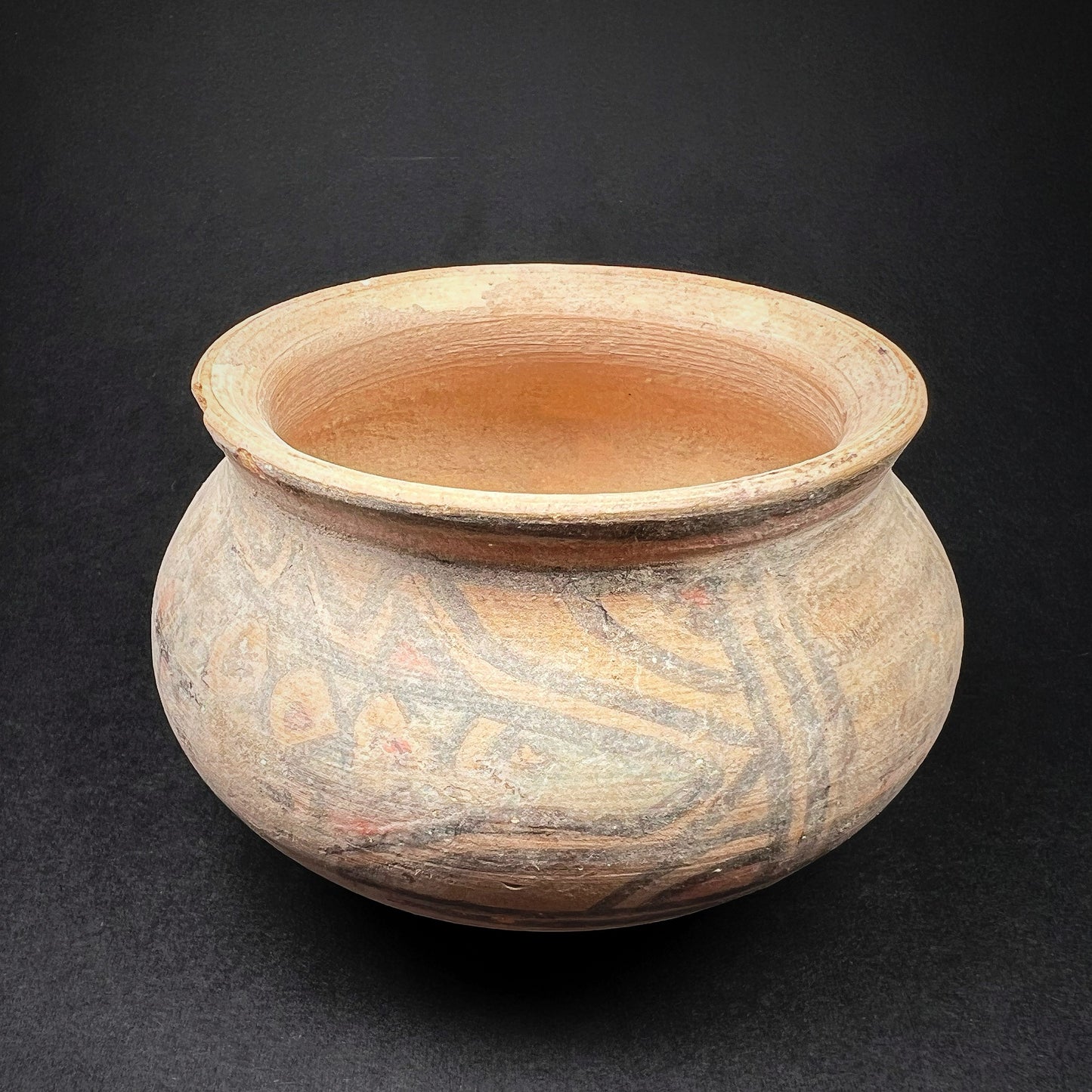Harappan Polychrome Terracotta Bowl with Fish Motif
Harappan Polychrome Terracotta Bowl with Fish Motif
Couldn't load pickup availability
Harappan Civilization, c. 2600–2450 BC, Sindh, Pakistan
An exquisite terracotta bowl from the height of the Harappan period, radiating the sophistication and symbolic depth of one of the ancient world’s most advanced urban cultures. This finely crafted vessel features a bulbous body resting on a flat, rounded foot, with a gently tapering neck and a flaring rim, all rendered in beautifully balanced proportions.
The exterior is embellished with a meticulously painted polychrome register, featuring two stylized fish alternating with panels of vertical linear motifs and geometric forms, executed in light brown pigment atop a cream-toned slip. The vibrant designs remain remarkably vivid, a testament to the Harappan mastery of ceramic pigments and brushwork. The interior is left intentionally undecorated, allowing the decorated exterior to speak for itself in terms of form, balance, and function.
Fish motifs are a recurring symbolic element in Harappan iconography, possibly reflecting themes of fertility, abundance, and the life-giving force of water—essential to both agriculture and spiritual belief in the Indus Valley. While the exact ritual or utilitarian use of this bowl remains open to interpretation, its refined decoration and form suggest it was an object of meaningful value.
The Harappan civilization (c. 3300–1900 BC), spanning across present-day Pakistan, northwest India, and Afghanistan, was noted for its urban planning, advanced infrastructure, and artistic expression through ceramics, seals, and sculpture. This rare and expressive vessel not only showcases the technical prowess and aesthetic vision of its makers but also offers a profound glimpse into the cultural soul of the Indus Valley.
A superb and evocative artifact, ideal for collectors and connoisseurs of ancient art.
Excellent condition. Small chip in the rim. Age-related light wear, abrasion and corrosion. Intact. Rich deposits on exterior. Size approx. 9,0cm x 9,0cm x 6,5cm.
Provenance: Dutch private collection
References and further reading:
The Harappan Civilisation: Its Sub-cultures, Roshen Dalal, The Pioneer, Thursday, 10 May 2018.
Indus Valley Civilization, Mark, Joshua J., World History Encyclopedia, Last modified October 07, 2020 (https://www.worldhistory.org/Indus_Valley_Civilization/).
The Indus Civilization: A Contemporary Perspective, Gregory L. Possehl, AltaMira Press, 2002.
The Harappan Civilization, Tarini Carr, Archaeology Online.
Indus Civilization, R.K. Pruthi, Discovery Publishing House, 2004, s. 157.





-
Shipping
The shipment will be prepared in the course of 3-5 days and dispatched via Posti Group Oyj or purchased item(s) can be picked up from our shop during the store's opening hours (Tarkk’ampujankatu 4, 00140, Helsinki, Finland). Within the Finland, all items are shipped via Posti Group Oyj unless otherwise requested. We pack the items carefully and mainly in recycled materials because we want to save nature. You will receive the tracking number for your items by e-mail.
-
Returns
Returns and exchange will be accepted within fourteen days (14) of receipt at the purchaser’s cost to include freight and packaging. Items must be returned in the same condition as when they were shipped, and will not be accepted if damaged or altered in any way. Please inform us via email (info@gotanmaailma.fi) or by calling +358408408352 before sending. We do not accept returns more than 14 days after delivery.





